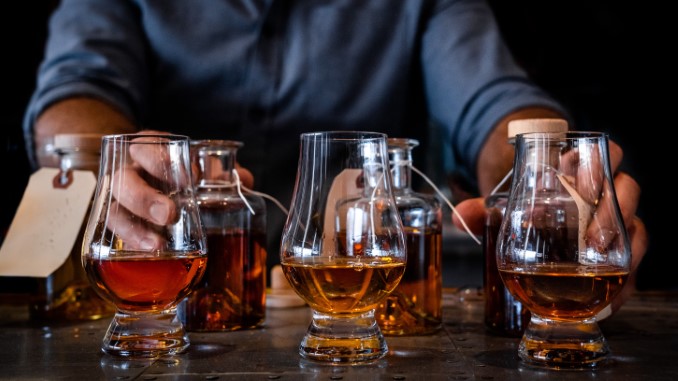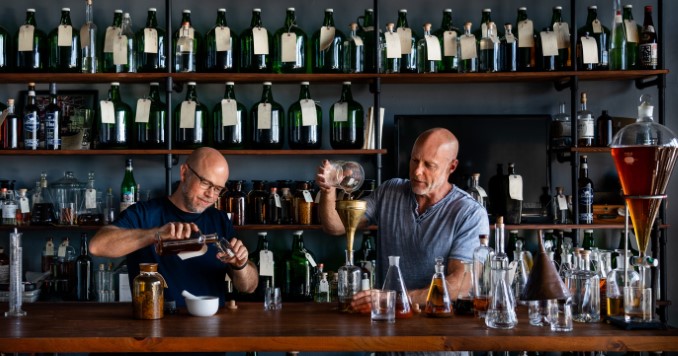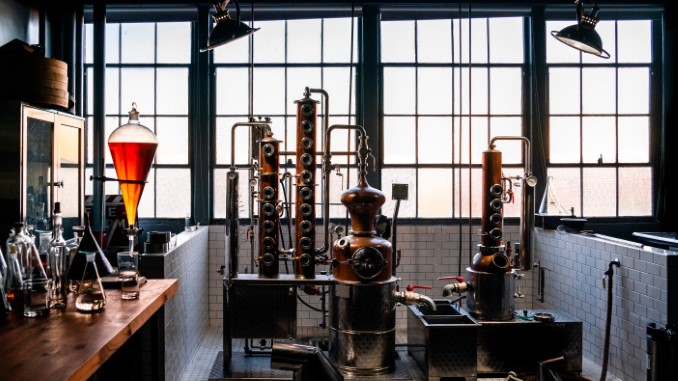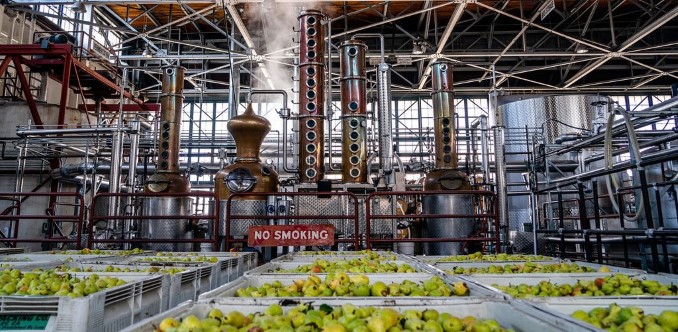The Subtle Alchemy of St. George Spirits, 40 Years Strong
Photos courtesy Alex Zyuzikov Drink Features distilleries
Pretty much every time Master Distiller Lance Winters or Head Distiller Dave Smith embarks upon the creation of a new product for Alameda, California’s storied St. George Spirits, they’re tacitly agreeing that the process won’t be nearly as simple as it could be. As Winters readily admits, the mere act of bulk fermentation and distillation really doesn’t have to be all that complex, or challenging. Making cartoonishly sweet, flavored vodka, or stock-standard American bourbon whiskey? Those are pretty simple tasks, when all is said and done, and people will line up to buy those products. But Winters and Smith aren’t interested in what is efficient, or what is undeniably marketable. When designing new spirits, they’re not asking themselves “what will sell?” Hell, they’re often not even sure they’ll have a chance to replicate the spirit a second time, for innumerable potential reasons. The reason for creation is the act itself, and the passion that powers it.
“We make things here because we find them beautiful,” says Winters succinctly, guiding a small group of journalists around the distillery. “Hopefully, we can find other people who find them beautiful later on.”
 Lance Winters and Dave Smith are tasked with discovering flavors outside of everyday experience.
Lance Winters and Dave Smith are tasked with discovering flavors outside of everyday experience.
Case in point: Something like St. George California Agricole Rum, which, as the name would imply, is a rum the distillery made in the style of Martinique/Guadeloupe rhum agricole, produced from fresh-pressed sugar cane juice rather than the more common molasses. A St. George-branded rum could easily have been produced from molasses, but early experimental batches simply didn’t produce flavors that Winters or Smith found compelling or novel. It wasn’t until they landed on rum produced from the labor-intensive, fresh-crushed juice of California-grown sugar cane that they thought they had an exceptional product—a fresh, citrusy, funky, herbaceous rum begging to be mixed into a Ti’ Punch or classic tiki cocktail. And indeed, it’s an exceptionally delicious rum … but the distillery hasn’t made a batch in years. And that’s primarily because the complexities of the agriculture market make California-grown sugar cane too difficult to source at the moment. Could St. George simply get back into the rum game at any point by switching to molasses? Absolutely, but that would be missing the point.
“What we made there was a product that, if you gathered up 100 self-professed rum fans, 95 of them might turn up their nose at it,” Winters said. “But that doesn’t matter. We were after those other 5 people.”
That story encapsulates much of the philosophy of St. George Spirits as it celebrates its 40th year in operation, built from humble beginnings in 1982 by original owner-distiller Jörg Rupf as a conduit to produce European-style eau de vie. That Rupf would open a business in California to pursue his interest in an unaged style of fruit brandy that still isn’t particularly popular or marketable now, 40 years later, speaks perfectly to the quixotic pursuits for which St. George has become famous. Four decades have passed, and the focus is still on the eclectic, the ephemeral, and the distinctive, even when it would be so much easier—and so much more profitable—to simply “do what works.” The tandem of distillers behind the company’s modern operation actively resist that kind of profit-centric mindset, because they know it would drag them away from making the kinds of discoveries that result in a product like California Agricole, or the bracingly bitter amaro Bruto Americano, or the beloved flagship Terroir Gin.
 The St. George lab, and its small pilot still, where dozens of new spirits have been born.
The St. George lab, and its small pilot still, where dozens of new spirits have been born.
Even the vodka rolling out of St. George is held to a standard of epicurean sophistication that one simply doesn’t see often in this industry, whether it’s the delicate and dry fruitiness of the California Citrus Vodka, or the instantly exotic payoff of the extremely popular Green Chile Vodka. The latter truly is a thing of beauty, composed from notes gleaned from four varieties of peppers—jalapeno, serrano, habanero and even bell pepper, paired with cilantro and lime. The distillery instructs tasters to expect not capsaicin heat, but “the brightness of salsa fresca,” to put them in the right mindset. In doing so, they immediately thwart consumer expectations for how a “chile spirit” will taste.
I want to make something extra clear, here: I am not a vodka consumer, and you likely won’t find many dedicated spirits writers who spend much time with vodka. A perfectly neutral or obnoxiously, artificially flavored spirit is classically something that I see as a waste of whatever units of ethanol I’ve chosen to allow myself for consumption on any given day, by which I mean that if I’m only going to allow myself to drink so much, I want it all to be spirits with a greater degree of complexity and character. I love spirits of all kinds, but vodka is the one arena I typically find safe to effectively ignore.
And yet, of all the spirits I tasted while visiting St. George, it was that Green Chile Vodka that indelibly opened my eyes, and in the process most clearly communicated the ethos of the company. It’s a beautifully complex array of flavors, both challenging and accessible—the subtle sweetness of a garden-grown red bell pepper, coupled with savory herbaceousness and earthy tones, and flashes of the fruitiness one can only access in a habanero after getting past wave after wave of heat. Only the faintest traces of that heat remain, lending soul to this tincture that is otherwise like the bottled essence of a farmer’s market pepper stand. More than any other spirit I tasted, this is the one that sent the mixologist corner of my brain hurtling through an endless series of permutations, imagining all the ways one might insert it into classic cocktails. This is the kind of product that spurs extemporaneous creativity, effectively transplanting the passion of its creators into the audience consuming it.
That’s the atmosphere one will find while stepping through the doors of St. George’s World War II-era aircraft hangar distillery, where one might see thousands of pounds of pears gathered in bins, awaiting their chance to be turned into pear brandy or an exceptional spiced pear liqueur. You might see Lance Winters or Dave Smith while you’re there, perhaps debating their opposing stances on the validity of barrel-aged gin, a fight that Smith seemingly won in the end, given the continued production of St. George Dry Rye Reposado Gin. Ask one of them about Japanese whisky highballs, meanwhile, and you’ll hear a philosophy on the drink as a “reconstructed beer,” inserting the water and carbonation back into a malt-based spirit that began its life as a beer transformed into whisky via distillation and aging, before coming full circle … sans the gluten. The duo at the heart of St. George are a font of these sorts of anecdotes, with an aura of inexhaustibility about them.
 Thousands of pears await their date with destiny.
Thousands of pears await their date with destiny.
Finally, among the relics and keepsakes that dot the facility, a sharp-eyed fan might notice a curious-looking whisky bottle, labeled as Glengoolie Blue. It is, of course, an Archer gag brought to life, a composite brand enjoyed by the show’s heavy-drinking spies since the series first aired in 2009. A small handful of bottles, complete with garrote-style pull tabs to open them, were created as a gift for the show’s cast, with whisky pulled and blended from St. George’s ever-evolving collection of casks. To Winters and Smith, it was a fun diversion, but other observers saw the economic potential that lay in such a collaboration. Why not turn an Archer-branded Glengoolie whisky into a full-time brand, one with a built-in market of fans? After all, there’s money to be made.
Winters and Smith never entertained the idea. Though fans may have been hungry for a chance to buy their own Glengoolie, the reality of producing it on a wide scale would have involved sourcing scotch whisky from overseas, and ultimately selling it at a significant markup, effectively putting branding over product quality. And if there’s one constant that becomes clear in exploring the philosophy at St. George, it’s that the people in charge would never choose to risk their reputation over sourced spirits—not after spending literal decades as pioneers in the art of American single malt whisky.
After 40 years, St. George Spirits isn’t about to start doing things the easy way.
Jim Vorel is a Paste staff writer and resident beer and liquor geek. You can follow him on Twitter for more food and drink writing.